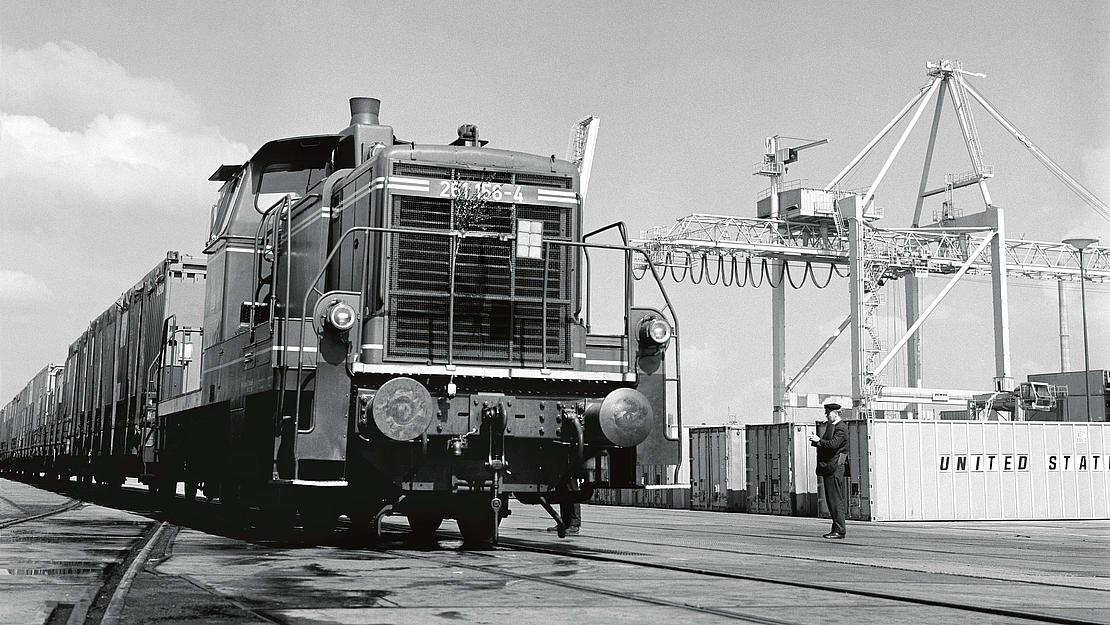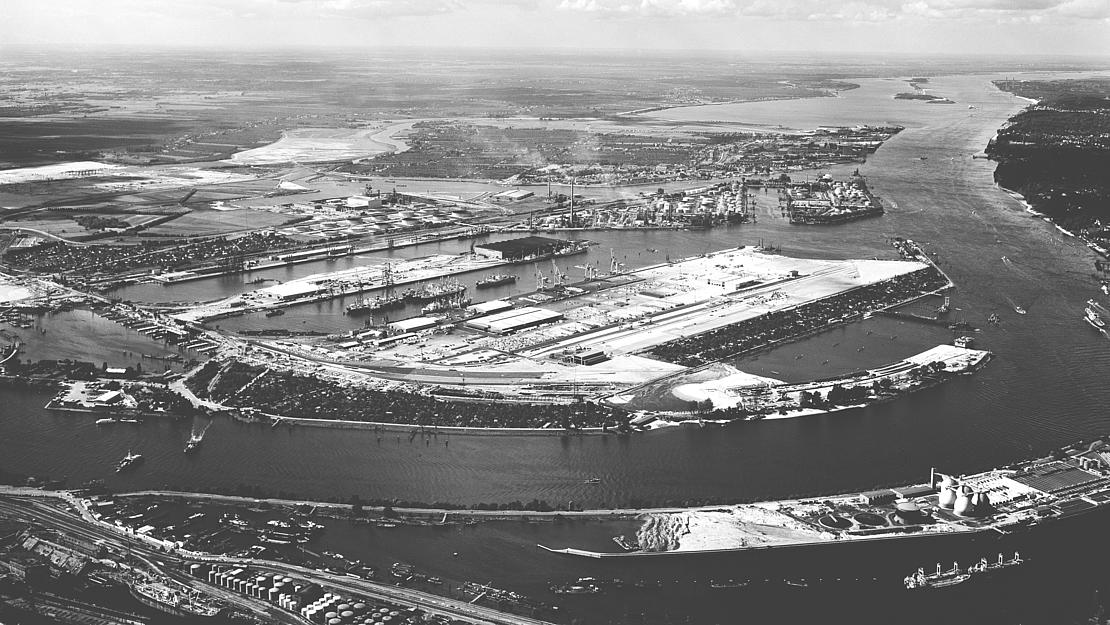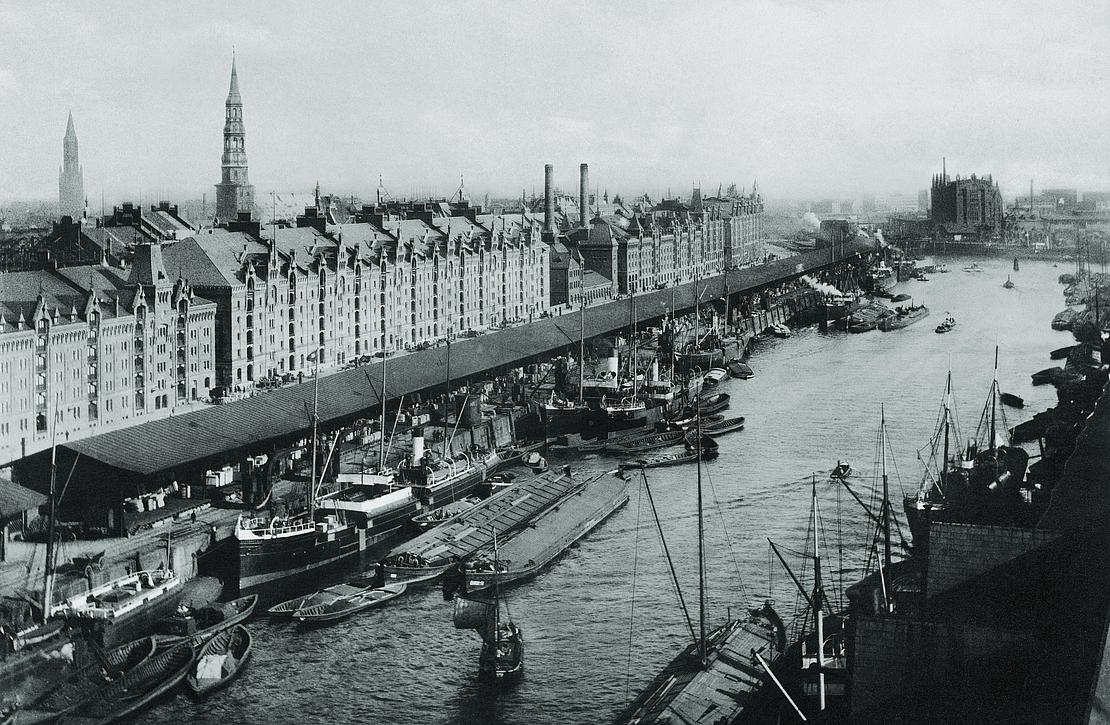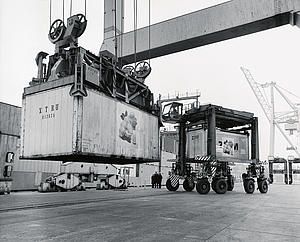Quicklinks
Quicklinks
With the birth of today’s Port of Hamburg in the 19th century, the rail system was also established. Rail connections to the European hinterland have been expanded ever since then and are still being expanded now – a decisive success factor for HHLA. A glance back in time shows that ship and rail are an unbeatable team.

The sounds of the Hamburg hymn “Hammonia” rang from hundreds of throats as a steam engine pushed the first freight cars into the brand new port facility at the “Sandthorquai” (Sandtorkai) on 11 August 1866. The facility consisted of seven large storage sheds, modern Brown steam cranes, a railway track in front and further tracks behind the sheds and bright gas lighting. The conditions were ideal for steam ship and rail – the new dream team in cargo transport.
The “Hamburger Nachrichten” newspaper reported it as a revolutionary innovation: “The rail carriages can drive right up to the quay allowing the ships to be loaded and unloaded directly.”
It had the potential to become a lucrative model. Hamburg’s shipping companies and merchants were therefore reluctant to hand over operation of railway traffic on the quay to the private company Berlin Hamburger Eisenbahn-Gesellschaft (BHEG). In order to remain in control, the city’s Senate founded the state quay administration in 1862, a predecessor of today’s HHLA.

At the time the Sandtorkai was opened, the Port of Hamburg was already well connected with the north (Kiel) and the east (Berlin and Lübeck) by rail. The result: just one and a half years later, in 1868, the quay was already fully overloaded. More than a fifth of the port’s total throughput ran through the quay, and a third of the more than 2,000 steam ships that the port saw each year docked there. The opening of the first bridge over the river Elbe in 1872 created another rail link to the south, pushing up cargo throughput further.
The combination of rail and ship remained decisive for the port’s development in the following decades, too. Large shunting rail terminals and a rail terminal belonging to the port – the port railway – connected the hinterland with the world’s oceans. The inland waterway ships on the river Elbe could not keep up for long. When the Sandtorkai was opened in 1866, 80 percent of the hinterland traffic was handled by inland waterway ships. Forty years later, in 1906, rail had caught up in terms of tonnage.


But then the Second World War came to Hamburg and the port was set back by enormous damage. Following reconstruction and the ensuing “Economic Miracle”, something was introduced in the sixties that resulted in an entirely new boom: the container as a universal transport vessel. The first container train called “Delphin” drove into HHLA’s Burchardkai container terminal (CTB) in 1968.
The port’s railway facilities also switched to electricity at that time in order to avoid the time-intensive swap between electric and diesel engines at port facilities. The establishment of district railway stations in the port area to optimise the availability of cargo trains and arranging wagons in the sixties and seventies also helped to speed up throughput around the port.
Another milestone in the port’s history was the reunification of Germany and the end of the division of Europe in 1990. This political event had a drastic impact on port logistics: with one fell swoop, the eastern part of Germany and the whole of Eastern Europe ceased to be inaccessible restricted areas. Huge demand for materials in the East so that the region could catch up meant entirely new consumption flows.

HHLA immediately recognised opportunities to improve the connections between their container terminals in Hamburg and the Eastern and Central European hinterlands. In those days, heavy goods vehicles sometimes waited for days in handling queues at the German-Polish border. Together with the logistics company Egon Wenk, HHLA developed a concept for a regular container block train service between the Port of Hamburg and Warsaw.
In September 1991, an EU judgement decreed open access to rail networks, which had previously been open only to national rail operators. This set the ball rolling. In January 1992, trains belonging to Polzug Polen-Hamburg-Transport GmbH were the first trains to roll on the tracks belonging to the national rail operators DB and PKP. HHLA initially held a 40 percent stake in the company, which rapidly became the market leader in multi-modal traffic with Poland.
In the former Czechoslovakia, too, HHLA had reacted quickly and established Metrans a.s. together with partners in the spring of 1991. The first Metrans terminal in Uhrineves, a district of Prague, began operations in October 1991, and the fist container train from Hamburg arrived there in February 1992. The traffic between Prague and Hamburg developed so quickly that other connections were soon added.

Metrans has a total of 20 terminals in the hinterland, of which five function as large hub terminals. Containers are transported from these hubs on the company’s own locomotives and wagons, as well as via seaport-hinterland traffic and, increasingly, continental traffic.
The success of Metrans and Polzug convinced Deutsche Bahn (DB) that a strategic cooperation with HHLA would be beneficial for both parties. As a result, HHLA acquired half of the shares in TFG Transfracht, a wholly owned subsidiary of DB with many years of experience in multi-modal traffic, at the beginning of 2002. In return, DB took approximately a third of the shares in Polzug and Metrans. However, this cooperation has since ended.
Metrans is now once more fully owned by HHLA and has merged with Polzug. Its rail network stretches from the Netherlands, Germany and Austria to Slovakia, the Czech Republic, Hungary, Slovenia and Croatia. Even Turkey and the asian "Silk Road" are connected.
Whenever handling at the Port of Hamburg grows, its loyal partner cargo rail must grow along with it. And if there are more trains available for the efficient transport of containers throughout Europe, the port in turn can handle more ships. This is how one of the largest handling facilities for rail containers in the world came to be. Rail and port profit from one another – in the past as they will in the future.